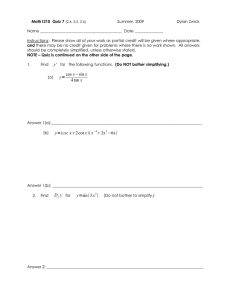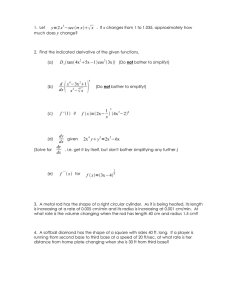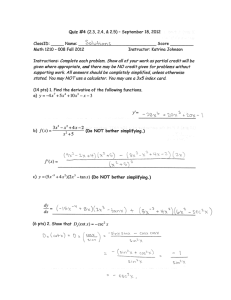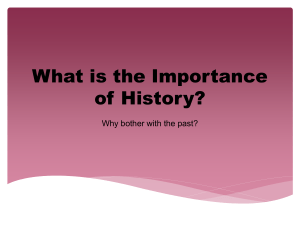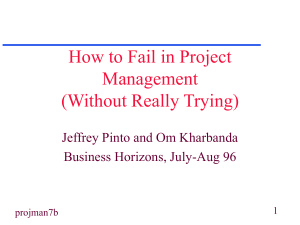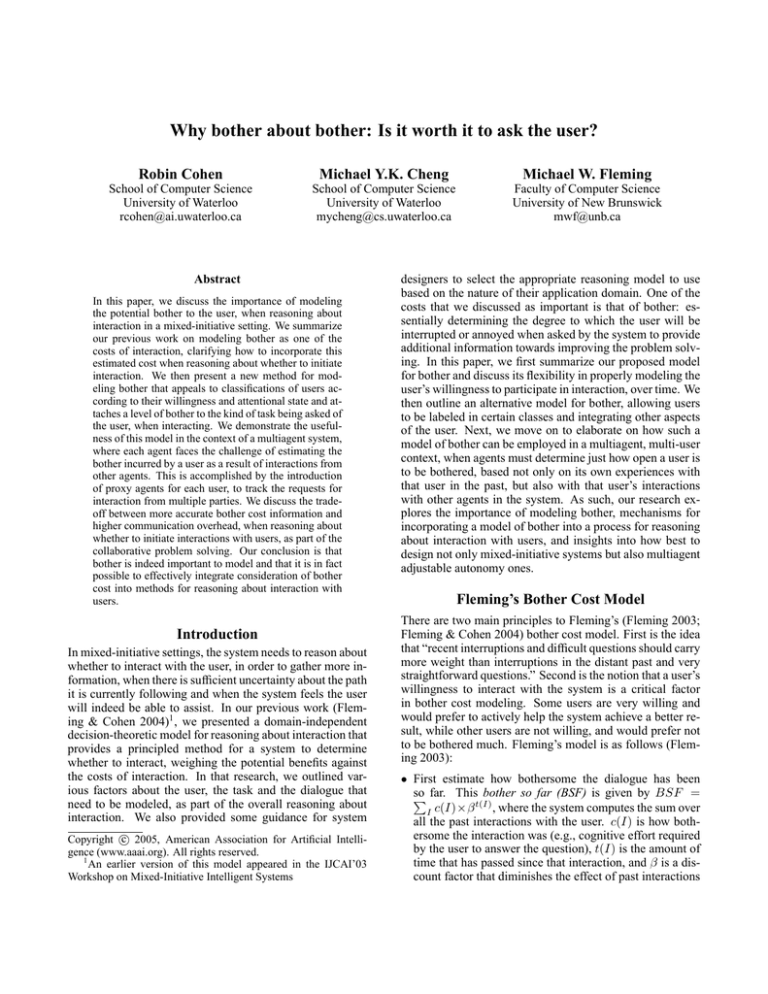
Why bother about bother: Is it worth it to ask the user?
Robin Cohen
Michael Y.K. Cheng
Michael W. Fleming
School of Computer Science
University of Waterloo
rcohen@ai.uwaterloo.ca
School of Computer Science
University of Waterloo
mycheng@cs.uwaterloo.ca
Faculty of Computer Science
University of New Brunswick
mwf@unb.ca
Abstract
In this paper, we discuss the importance of modeling
the potential bother to the user, when reasoning about
interaction in a mixed-initiative setting. We summarize
our previous work on modeling bother as one of the
costs of interaction, clarifying how to incorporate this
estimated cost when reasoning about whether to initiate
interaction. We then present a new method for modeling bother that appeals to classifications of users according to their willingness and attentional state and attaches a level of bother to the kind of task being asked of
the user, when interacting. We demonstrate the usefulness of this model in the context of a multiagent system,
where each agent faces the challenge of estimating the
bother incurred by a user as a result of interactions from
other agents. This is accomplished by the introduction
of proxy agents for each user, to track the requests for
interaction from multiple parties. We discuss the tradeoff between more accurate bother cost information and
higher communication overhead, when reasoning about
whether to initiate interactions with users, as part of the
collaborative problem solving. Our conclusion is that
bother is indeed important to model and that it is in fact
possible to effectively integrate consideration of bother
cost into methods for reasoning about interaction with
users.
Introduction
In mixed-initiative settings, the system needs to reason about
whether to interact with the user, in order to gather more information, when there is sufficient uncertainty about the path
it is currently following and when the system feels the user
will indeed be able to assist. In our previous work (Fleming & Cohen 2004)1 , we presented a domain-independent
decision-theoretic model for reasoning about interaction that
provides a principled method for a system to determine
whether to interact, weighing the potential benefits against
the costs of interaction. In that research, we outlined various factors about the user, the task and the dialogue that
need to be modeled, as part of the overall reasoning about
interaction. We also provided some guidance for system
c 2005, American Association for Artificial IntelliCopyright gence (www.aaai.org). All rights reserved.
1
An earlier version of this model appeared in the IJCAI’03
Workshop on Mixed-Initiative Intelligent Systems
designers to select the appropriate reasoning model to use
based on the nature of their application domain. One of the
costs that we discussed as important is that of bother: essentially determining the degree to which the user will be
interrupted or annoyed when asked by the system to provide
additional information towards improving the problem solving. In this paper, we first summarize our proposed model
for bother and discuss its flexibility in properly modeling the
user’s willingness to participate in interaction, over time. We
then outline an alternative model for bother, allowing users
to be labeled in certain classes and integrating other aspects
of the user. Next, we move on to elaborate on how such a
model of bother can be employed in a multiagent, multi-user
context, when agents must determine just how open a user is
to be bothered, based not only on its own experiences with
that user in the past, but also with that user’s interactions
with other agents in the system. As such, our research explores the importance of modeling bother, mechanisms for
incorporating a model of bother into a process for reasoning
about interaction with users, and insights into how best to
design not only mixed-initiative systems but also multiagent
adjustable autonomy ones.
Fleming’s Bother Cost Model
There are two main principles to Fleming’s (Fleming 2003;
Fleming & Cohen 2004) bother cost model. First is the idea
that “recent interruptions and difficult questions should carry
more weight than interruptions in the distant past and very
straightforward questions.” Second is the notion that a user’s
willingness to interact with the system is a critical factor
in bother cost modeling. Some users are very willing and
would prefer to actively help the system achieve a better result, while other users are not willing, and would prefer not
to be bothered much. Fleming’s model is as follows (Fleming 2003):
• First estimate how bothersome the dialogue has been
so far. This bother so far (BSF) is given by BSF =
P
t(I)
, where the system computes the sum over
I c(I)×β
all the past interactions with the user. c(I) is how bothersome the interaction was (e.g., cognitive effort required
by the user to answer the question), t(I) is the amount of
time that has passed since that interaction, and β is a discount factor that diminishes the effect of past interactions
as time passes.
• Let w represent the user willingness, with a range of 0 to
10, with higher w meaning more willingness.
• Let α = 1.26 − 0.05w and Init = 10 − w.
1−αBSF
• Then, BotherCost = Init + 1−α . From this formulation, a lower willingness w results in a higher Init cost,
and also a higher α value (which amplifies the effect of
the bother so far BSF ). As BSF increases, so too does
BotherCost, but at different rates, depending on the α
value. As shown in (Fleming 2003), for low w values, α
will be greater than 1, and we will see an exponential-like
increase due to BSF , while for high w values, α will be
less than 1, and we see a log-like increase.
This model of bother cost is incorporated into a formula for
reasoning about interaction in mixed-initiative systems that
weighs the benefits of interacting (the expected increase in
the utility of the problem solving gained by asking a question) against the costs of interacting. These costs include
a time cost (the cost associated with the additional time required for the interaction) and bother cost, and when the total of these costs exceeds the anticipated benefit, the system
will decide not to initiate interaction. See (Fleming & Cohen
2004) for details.
Proposed Bother Cost Model
Below we present a richer model of bother cost, of use in
settings where agents may be interacting with users either
to query for information or to simply transfer decision making control. These are both referred to as transfer-of-control
(TOC) actions2 . It is important to note that we are not aiming to develop the definitive bother cost model. Instead, we
are proposing a working model that we can use in this paper that incorporates the current bother cost research in the
field. From previous works, we have extracted the following
factors which are believed to influence bother cost:
• The
difficulty
of
the
interruption
query,
T OC Base Bother Cost.
For example, usually,
asking a user his/her preference is easier (i.e., cognitively
less intense) than asking a user to decide on a plan of
action.
• The
attention
state
of
the
user,
Attention State F actor3 . For instance, a user is
more interruptible when resting than when he/she is busy
with important work.
• How willing a user is to interact with the system.
U ser U nwillingness F actor4 is a measure of how receptive the user is towards being TOC’ed, and how well
they handle interruptions.
2
Note that this extends the concept of a TOC strategy used in the
Electric Elves (E-Elves) project (Scerri, Pynadath, & Tambe 2002),
which is restricted to just transfers of decision making control
3
This concept is drawn from the work of (Horvitz & Apacible
2003)
4
In developing the proposed bother cost model, we found it
more intuitive to think of unwillingness being a high value (compared to willingness being a high value)
• The timings of the interruptions, t(T OC), and the discount factor, β (0 < β < 1), which reduces the bother
impact of past TOCs as time passes5 .
By logically adapting Fleming’s (Fleming 2003) bother cost
model to incorporate the findings of other researchers, we
propose the following enhanced bother cost model:
• Init
=
U ser U nwillingness F actor ×
TOC Base Bother Cost
Attention State F actor×
• BSF
(Bother
So
Far)
=
P
×
toc∈P astT OC T OC Base Bother Cost(toc)
β t(toc) , where P astT OC is the set of all the past TOCs
experienced by the user, T OC Base Bother Cost(toc)
is just the T OC Base Bother Cost of toc, and t(toc)
is the time point at which toc occurred.
• To determine the increase to the bother
cost due to BSF ,
we have a function,
BC Inc F n(BSF, U ser U nwillingness), that maps a
BSF value to a bother cost increase, based on the user’s
unwillingness level.
• BotherCost
(BC)
=
Init
+
BC Inc F n(BSF, U ser U nwillingness).
Here are some suggestions for possible bother cost factor
values6 :
• [T OC Base Bother Cost]
Easy=5, Medium=10,
Hard=20
• [Attention State F actor] Relaxed=0.75, Neutral=1,
Busy=1.25
Willing=0.5, Neu• [U ser U nwillingness F actor]
tral=1, Unwilling=2
• [β] 0.90
• [BC Inc F n] For Willing, BC Inc F n(x) = x0.75 ,
for Neutral, BC Inc F n(x) = x1 , for Unwilling,
BC Inc F n(x) = x1.25 . This gives us roughly the same
bother cost shape as used in (Fleming 2003)7 .
5
Note: The value of β depends on the size of the time step. If
a time step is ‘huge’, then β should be low (to reflect that one time
step means a lot of time has elapsed, and so we should discount
more), while inversely, if the time step is ‘small’, then β should be
high. Also, it is conceivable that the value of β will depend on the
particular person. For this paper, we assume (for simplicity’s sake)
that it is the same value for all users.
6
Note: These are only example suggestions. In the real world,
the system designer would want to tailor the values to the domain.
For instance, the domain might require finer granularity in terms
of the number of attention states, or, perhaps the differences between willing and unwilling users are greater, necessitating greater
differences in BC Inc F n(BSF, U ser U nwillingness).
7
Note: For BSF less than 1, we might want to use different functions, else we get the somewhat odd result that there is
more bother increase for Willing users than Unwilling users. A
work-around is to do something like BC Inc F n(x) = (x +
1)willingness rate − 1. However, with BSF less than 1, the increase in bother cost is negligible and so this slight difference is
virtually irrelevant.
Reasoning about Bother in Multiagent Settings
Interesting challenges arise when an agent is trying to model
bother cost in a cooperative multiagent system. While an
agent has up-to-date records regarding the bother cost of various users in the single agent case, this is no longer true in
the multiagent systems case. From an individual agent’s perspective, the bother so far (BSF ) of users may change for
reasons other than as a result of its own actions. In particular, BSF of users may change due to the actions of other
agents in the system. Unless mechanisms are in place to
address this, agents will likely have ‘stale’ local data about
users’ bother so far. The problem with stale bother data is
that it is possible for an agent to think that it is optimal to
interact with a user, when in actuality, it is not, since that
user has already been bothered too much by other agents in
the system. As such, we would like the agents to propagate
bother cost information amongst themselves in order to keep
each other updated. However, at the same time, we do not
want to overburden the communication channels. So, there
is a trade-off between keeping agents updated (which affects
the quality of agent operation), and minimizing the amount
of agent communication required. We now outline three different designs of agents with respect to bother cost information sharing, namely TypeI, TypeII, and TypeIV agents8 . We
first make the following assumptions/simplifications in this
paper:
• We focus on sharing users’ bother cost information
amongst the agents, not other types of information such
as domain specific information.
• Each user (U seri ) has his/her own proxy agent (Proxyi ).
This is a reasonable assumption and is similar in fact to
what occurs in the E-Elves project (Scerri, Pynadath, &
Tambe 2002) where each user has a personal assistant
agent9 . In order for an agent to interact with a user, it has
to go through that user’s proxy agent first. To differentiate between the proxy agent, and the agent which initiates
the interaction, we shall denote the latter as ‘requesting
agent’ or sometimes simply as ‘agent’, while the former
will always be noted as ‘proxy agent’.
• Representing bother cost is employed in conjunction with
a model for reasoning about interaction that allows agents
to select the optimal TOC strategy, determining who to
transfer control to (either for information gathering or decision making) and how long to wait for a response before attempting a different transfer. The particular model
that we have developed is not explained in detail here (see
(Cheng & Cohen 2005) for further details). It is important to note that selecting a TOC strategy requires modeling the expected quality of decision obtained as a result of
the transfer (EQ, as in (Scerri, Pynadath, & Tambe 2002))
8
In our research, we have also developed another type of information sharing agent named TypeIII. TypeIII agents are in fact
subsumed by TypeIV agents, and as such, we only describe TypeIV
agents in this paper.
9
Note that in E-Elves, the personal assistant agent does not perform the coordination function that we envision our proxy agents
doing.
and the probability of response, balanced against the costs
of waiting for a response and bothering the user. As a
simplification, we will assume that users who are asked
are able to provide responses and that the length of TOC
strategies is at most 1. As such, the key term to consider
for the expected utility (EU) of a strategy is EQ − BC.
Agent Type I (Broadcast)
This type of agent emphasizes up-to-date information, with
the benefit of high utility (EQ−BC) achieved by the agents,
at the cost of high communication overhead. There are two
ways to do this: [Push] Whenever a user is bothered (i.e.,
TOC’ed), his/her proxy agent will broadcast this news to
all agents in the society, and [Pull] Whenever an agent is
about to enter its optimal TOC strategy reasoning process, it
will first broadcast poll all the proxy agents for the current
bother cost data of their users. For this research, we go with
the push approach, since there is no time lag involved (i.e.,
agent can start planning right away, instead of waiting to
receive all the poll information). When a TypeI agent needs
a decision made, the process is as follows:
1. Using its up-to-date bother cost information, the agent determines an optimal TOC strategy, which specifies transferring control to a particular user, U seri .
2. The agent sends a TOC request (which includes the TOC
question to ask) to proxy agent Proxyi who will in turn,
relay the TOC question to U seri .
3. Proxyi broadcasts an update/notification message to all
agents in the system, to alert them of the TOC event.
4. When an agent receives a notification message, it will update the bother so far (BSF ) value for U seri , so that future TOC strategy planning will be accurate.
Agent Type II (No Information Sharing)
This type of agent stresses low communication overhead
(actually no overhead) by not communicating bother cost information at all. Agents only look at their own past actions
(TOCs) when determining the BC values used in the optimal TOC strategy reasoning. In a way, they can be viewed
as extreme optimists, hoping that no other agents have done
any TOCs recently to the users that they want to transfer
control to. The consequence of this is that the BC value
used to find the optimal TOC strategy will always be less
than or equal to the actual BC value. This is easy to see
from the bother cost model, because TOC events can only
increase BSF , which increases BC. When an agent is not
aware of TOC events, its estimated BC value will be lower
than the actual BC value. Subsequently, the perceived EU
of a strategy may be higher than the actual EU of the strategy, leading the agent to possibly select a TOC strategy that
is less than optimal (in the sense that there is another strategy that has a lower perceived EU , but a higher actual EU
value). When a TypeII agent needs a decision made, the
process is as follows:
1. Using its possibly stale bother cost information, the agent
determines an optimal TOC strategy, which specifies
transferring control to a particular user, U seri .
2. The agent sends a TOC request (which includes the TOC
question to ask) to proxy agent Proxyi who will in turn,
relay the TOC question to U seri .
1. Using its possibly stale bother information, the agent determines an optimal TOC strategy, which specifies transferring control to a particular user, U seri
3. Only the requesting agent and Proxyi are aware of the
TOC event, and so only they update their bother so far
(BSF ) value for U seri .
2. The agent sends a TOC request (which includes the TOC
question to ask and the estimated BC of U seri ) to proxy
agent Proxyi .
Agent Type IV (Verify Plan within Threshold)
This type of agent aims to achieve a compromise between
the two extreme types of agents described above. It will
plan its TOC strategy based on possibly stale information,
but will verify that its plan is accurate enough (in terms of
BC) with the proxy agent, before executing the strategy. If
the verification succeeds (i.e., anticipated BC value is reasonably correct), then the plan execution proceeds. Otherwise, the proxy agent will notify the requesting agent of the
actual BC value. After receiving the update, the agent will
recalculate its optimal TOC strategy, and execute it. This
may involve the agent not TOC’ing and making the decision itself, or retrying a TOC (possibly to the same user, or
another user). Note that a proxy agent will always have upto-date bother cost information about its own user, since all
TOC requests go through it.
While this cuts down on the communication cost (as compared to Type I agents), and it is sensitive to bother cost by
other agents (which is not the case with Type II agents), there
is however, a new type of cost introduced in terms of retry,
where a Type IV agent may have its plan rejected, and have
to recompute a new optimal strategy and assuming the new
strategy involves a TOC, verify the estimated bother cost
again. This introduces a slight time lag between when an
agent first determines a TOC strategy, and when it actually
executes the strategy, not to mention two extra messages being sent per retry (one message for request rejection, which
contains the updated BSF value, and one extra message for
TOC request/verify).
It is for this reason that we allow for some possible lack
of optimality in EU in order to reduce the number of retries
encountered. Basically, due to the nature of the bother cost
model, the impact of a TOC event diminishes with the passage of time. So, an unknown TOC event that occurred in
the distant past would cause very little increase in BC (due
to the discounting factor). In these cases, it makes sense
for the agent’s plan to go ahead, and not get rejected. For
instance, if an agent’s estimate of BC is off by 0.1, then
we should just go ahead with the strategy, instead of doing a
retry. So, with the TypeIV approach, upon receiving the estimated BC value from the requesting agent, the proxy agent
will see by how much the estimated BC differs from the actual BC. If the difference (error) is below some threshold,
T hresholdacceptable error , then the proxy agent will accept.
Due to this, a TypeIV agent is no longer guaranteed to have
the EU of TypeI agents, but it can still be reasonably assured
of a high EU because its selected strategy EU can never be
off by more than T hresholdacceptable error per proxy agent
involved. By being more ‘lenient’, we can reduce the number of retries. When a TypeIV agent needs a decision made,
the process is as follows:
(a) [If
(ActualBC
− EstimatedBC
≤
T hresholdacceptable error )]
Then Proxyi relays
the TOC question to its user U seri , and sends a reply
to the requesting agent that the plan was accepted.
Both the requesting agent and Proxyi update their
information about U seri ’s bother so far value.
(b) [Otherwise (ActualBC - EstimatedBC
>
T hresholdacceptable error )] Then Proxyi replies
to the requesting agent with a rejection message, which
contains information about the actual BSF value. The
requesting agent updates its information, and goes
back to step 1.
Experiments
To see how the different agent types would fare in different
situations, we ran simulations where we varied the model
parameters. Each simulation mimics a real world situation,
where there are a set of agents and a set of users, and as time
progresses, an agent may find that it needs a decision made
(we refer to this as an ‘event’). When an agent encounters an
event, it will proceed to obtain a decision in a manner specified by its agent type. In this section, we first describe the
experiment set-up, and then the results of the experiments.
Experiment Set-up
A simulation trial involves three main components: (i) a set
of agents, (ii) a set of users, and (iii) a set of ‘need decision’
events. Here are the default settings of each trial:
• There are 50 users and 50 agents in the system.
• There are 5 decision classes, and for each decision class,
a uniformly randomly generated number from the range
[50,100] is assigned to each user, to serve as that user’s
EQ value for that decision class. This is done to address
the fact that different users have different capabilities in
handling different types of decisions.
• There are 100 timesteps taken per trial, and for each
timestep ti and agent agentj , there is a 0.05 chance that a
‘need decision’ event will occur for agentj at timestep ti .
The particular class of decision needed will be uniformly
randomly assigned from the range [1,5].
• For TypeIV agents, T hresholdacceptable
error
= 10.
• The bother cost model parameter values used
in the simulation are the ones suggested in
the Bother Cost Model section.
In particular, β = 0.90, Attention State F actor = 1,
T OC Base Bother Cost = 10, and for each of
the users, they are uniformly randomly assigned a
user willingness type from the set, {Willing, Neutral,
Unwilling}.
A simulation trial starts by generating all the random values it needs (as described above). Then, it proceeds to run
the simulation for each agent type, and records the performance measurements (e.g., total utility and communication
overhead). An experiment runs 20 simulation trials, and
averages the results. This is to offset possible ‘odd’ results
from ‘oddly’ generated random numbers. As a side note,
this is why in the results section, we see decimals for certain
performance measurements that are ordinarily integers (e.g.,
the number of retries may be a decimal number).
Experiment Results
Results of One Simulation Trial Run
The
results of doing one simulation trial run, using the default trial parameters are as follows:
TypeI TypeII TypeIV
AverageUtility
82.23
73.33
80.97
STDev (Utility)
4.47
12.01
4.73
# Broadcasted Msgs 11564
N/A
N/A
# Retries
N/A
N/A
223
Average Retry Chain
N/A
N/A
0.94
As we can see, TypeI agents achieved the highest AverageUtility, with AverageUtility being the average utility
achieved for a decision event10,11 . However, TypeI agents
sent an enormous number of broadcasted messages (essentially every TOC results in #Agents − 1 messages).
TypeII agents fared the worst in terms of AverageUtility, but
had absolutely no extra communication messages. TypeIV
seems to be a nice compromise, with just slightly lower
AverageUtility than TypeI, and a reasonably low number of
retries (and so a low average retry chain12 ).
Results of Varying T hresholdacceptable error The main
results of varying T hresholdacceptable error are shown in
Figure 1. As can be seen from both graphs, varying the
threshold level is basically making a tradeoff between utility and the number of retries. As the threshold decreases,
TypeIV agents exhibit higher average utility (like TypeI
agents) and higher number of retries. The opposite is true;
as threshold increases, TypeIV agents shifts towards TypeII
agents, with lower average utility, but almost no retries. A
system designer should set the threshold level that achieves a
beneficial medium between the two extremes. For instance,
for the default settings in our experiment, a threshold set
at 10 may be a good compromise, as it suffers little average utility loss, but manages to reduce the number of retries
significantly. By assigning a utility cost to retry, a system
designer can examine a plot such as Figure 1 and select the
10
Note: For the utility value, we only count EQ − BC. The
coordination overhead cost is counted separately.
11
In the results table, we also show STDev. This is the standard
deviation of the utility values. Note that TypeII agents have really
high STDev, since sometimes agents TOC unbothered users (so
higher utility) and sometimes agents TOC very bothered users (so
much lower utility).
12
A retry chain denotes the number of TOC retries that an agent
has to perform before getting a TOC request accepted. This is
equivalent to the number of times an agent gets rejected before
having a TOC request accepted.
Figure 1: (a) Graph showing how average utility varies as acceptable BC estimate error varies. (b) Graph showing how
the number of retries varies as acceptable BC estimate error
varies.
optimal threshold level.
Results of Varying the Number of Agents and Users
We ran three separate experiments, varying the number
of agents and users in the system, as a test of how well
each of the agent types scale. The agent/user numbers are
5, 50, 500. The results of the experiments are follows:
5 Agents and 5 Users
TypeI
TypeII TypeIV
AverageUtility
78.18
77.74
77.98
# Broadcasted Msgs
108.2
N/A
N/A
# Times Retry
N/A
N/A
1.7
50 Agents and 50 Users
TypeI
TypeII TypeIV
AverageUtility
85.12
77.10
83.67
# Broadcasted Msgs
12218.15
N/A
N/A
# Times Retry
N/A
N/A
218.2
500 Agents and 500 Users
TypeI
TypeII TypeIV
AverageUtility
85.56
31.88
83.34
# Broadcasted Msgs 1252664.65
N/A
N/A
# Times Retry
N/A
N/A
23260
The main things to note from the results are the following:
When the number of agents in the system is low (and
assuming ceteris paribus), then there is not much difference
between the different agent types, since there is not much
chance of ‘overuse’ of the same user. On the other hand,
from the 500 agents experiment, we see that the TypeII (no
coordination) approach suffers greatly in terms of average
utility, as all the agents are trying to access the same users.
Not surprisingly, the coordinated approaches (TypeI, and
TypeIV) all manage to do fairly well in terms of average
utility, but note that they don’t all scale equally well in
terms of overhead cost. For instance, TypeI requires a
huge number of broadcasted messages as the number of
agents in the system increase. While TypeIV also requires
more overhead (i.e., retries), it is not as dramatic. As well,
even though there was undoubtedly less bother cost being
incurred in the experiment with only 5 agents and users, the
average utility was lower due to the low number of users.
With a low number of users, and randomly generated user
EQ values, it is less likely that there will be a user that will
have a very high EQ value for a particular decision class.
Discussion and Conclusion
This research can be seen as contributing to the development
of mixed-initiative systems by proposing methods, rooted in
user modeling, for managing dialogues between system and
user, towards effective overall problem solving. In particular, we believe that a principled method for designing mixedinitiative systems should reason about whether to interact,
and that this should be sensitive to an appropriate model of
bother to be incurred by the user. We also describe how this
method of reasoning can be applied in contexts where there
are multiple users and multiple agents, outlining the relative
tradeoffs between improving the accuracy of the bother cost
model and reducing communication overhead, to direct the
problem solving.
Our research discusses the value of proxy agents in facilitating the exchange of information about bother incurred
by users, towards the selection of more effective interaction
strategies by agents. This provides a more productive mechanism for agents to solicit user feedback as part of their processing. The work of Schreckenghost et al. (Schreckenghost
et al. 2002) is relevant, as it also advocates the use of proxy
agents in the context of multi-user, multiagent systems with
adjustable autonomy. That effort is focused, however, on the
use of proxies to coordinate the completion of tasks among
multiple agents. In addition, we address a problem acknowledged as important by the authors, that of allowing interruptions to users and agents, during the processing.
Even in contexts where there is some preferable global
strategy for balancing the level of autonomy between the
system and user, for example allowing for strong collaboration between parties, as outlined in (Barber, Gamba, &
Martin 2003), it is useful to allow some specific modeling of
the users in the community, in order to make decisions about
interaction. Our research outlines how bother can be an important factor in making these interaction decisions; for instance, users may be currently occupied with other tasks and
even if they are committed to being helpful, it may be preferable not to initiate interaction with them.
For future work, it would be interesting to explore the usefulness of our approach in contexts where the user takes the
initiative to direct the problem solving. For instance, Myers
and Morley (Myers & Morley 2003) propose a framework
for a user to specify when an agent should adjust its autonomy and elicit further input. In environments where there
may be multiple agents directed by a single user, it will be
critical for those agents to coordinate their efforts, even if
governed by rules initially set by the user. This coordination
could be achieved if the agents were, at the same time, corresponding with the proxies of the users, to confirm whether
it was indeed desirable for them to interact with the user, at
this point in time.
Others have explored the concept of bother as a factor in designing mixed-initiative systems, including Horvitz
(Horvitz & Apacible 2003) and Bauer (Bauer, Dengler, &
Paul 2000). Our research aims to deepen the modeling of
bother to incorporate various aspects of the user and of the
task, and to appreciate the challenges of properly modeling
that bother in environments where there are multiple users
and multiple agents. Our conclusion is that it is not sufficient to simply equip each individual agent with a similar
process for reasoning about interaction but that there must
also be a way of coordinating their modeling. We have also
shown some value to modeling the bother to be incurred by
users in terms of distinct factors, the values of which are determined on the basis of classifying the user into one of a
number of distinct categories.
Acknowledgements
We thank the Natural Sciences and Engineering Research
Council of Canada for the financial support.
References
Barber, K.; Gamba, I.; and Martin, C. 2003. Agent Autonomy (H. Hexmoor, C. Castelfranchi and R. Falcone, eds.).
chapter 3. Representing and analyzing adapative decision
making frameworks.
Bauer, M.; Dengler, D.; and Paul, G. 2000. Instructible
agents for web mining. In Proceedings of International
Conference on Intelligent User Interfaces, 21–28.
Cheng, M., and Cohen, R. 2005. A hybrid transfer of
control model for adjustable autonomy multiagent systems.
In Proceedings of AAMAS’05.
Fleming, M., and Cohen, R. 2004. A decision procedure
for autonomous agents to reason about interaction with humans. In Proceedings of the AAAI 2004 Spring Symposium
on Interaction between Humans and Autonomous Systems
over Extended Operation, 81–86.
Fleming, M. 2003. Reasoning about Interaction in MixedInitiative Artificial Intelligence Systems. Ph.D. Dissertation, University of Waterloo.
Horvitz, E., and Apacible, J. 2003. Learning and reasoning
about interruption. In Proceedings of the 5th International
Conference on Multimodal Interfaces (ICMI’03), 20–27.
Myers, K., and Morley, D. 2003. Agent Autonomy (H.
Hexmoor, C. Castelfranchi and R. Falcone, eds.). chapter
9. Policy-based Agent Directability.
Scerri, P.; Pynadath, D.; and Tambe, M. 2002. Why the elf
acted autonomously: Towards a theory of adjustable autonomy. In Proceedings of AAMAS’02.
Schreckenghost, D.; Martin, C.; Bonasso, P.; Kortenkamp,
D.; Miliam, T.; and Thronesbery, C. 2002. Supporting
group interaction among humans and autonomous agents.
In Proceedings of AAAI02 workshop on Autonomy, Delegation and Control: From Inter-Agent to Groups, 72–77.

